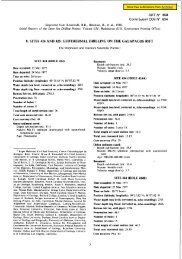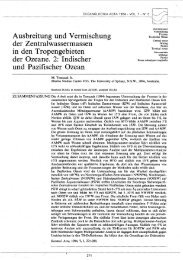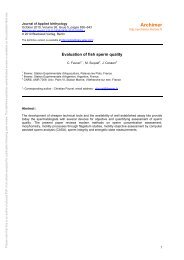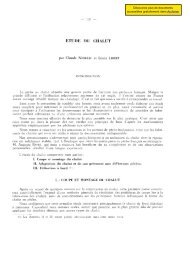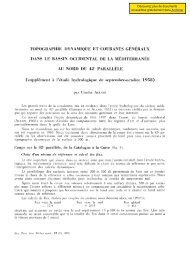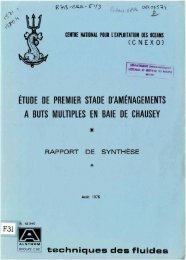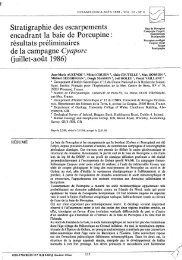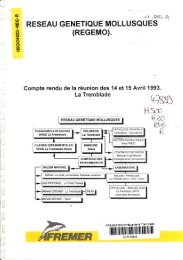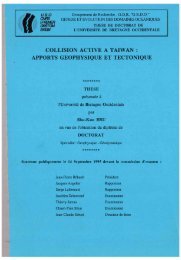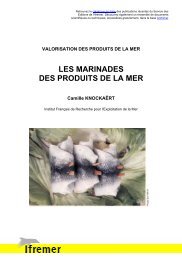Approche quantitative de la fonction de nourricerie jouée par les ...
Approche quantitative de la fonction de nourricerie jouée par les ...
Approche quantitative de la fonction de nourricerie jouée par les ...
Create successful ePaper yourself
Turn your PDF publications into a flip-book with our unique Google optimized e-Paper software.
3.2. Sampling methods.......................................................................................................................123<br />
3.3. Analyses. .....................................................................................................................................125<br />
4. RESULTS. ..............................................................................................................................................125<br />
4.1. Composition of the fish popu<strong>la</strong>tion of the Aiguillon bay : ..........................................................125<br />
4.2. Size structure and colonising guilds :.........................................................................................126<br />
4.3. Temporal variations in the fish popu<strong>la</strong>tion of the Aiguillon bay : ..............................................130<br />
4.4. Spatial variations in the fish popu<strong>la</strong>tion of the Aiguillon bay : ..................................................131<br />
4.5. Composition of the fish popu<strong>la</strong>tion of the Mont Saint-Michel bay : ...........................................133<br />
4.6. Seasonal com<strong>par</strong>ison of the two fish popu<strong>la</strong>tions (Aiguillon com<strong>par</strong>ed to Mont Saint-Michel) :<br />
136<br />
5. DISCUSSION. .........................................................................................................................................137<br />
5.1. The Aiguillon bay and the Mont Saint-Michel bay, two mo<strong>de</strong>ls of nurseries : ...........................138<br />
5.2. Management activities, disturbance and the nursery function of Aiguillon bay :.......................139<br />
5.3. Salt marshes, nursery function and colonising guilds : ..............................................................140<br />
6. CONCLUSION.........................................................................................................................................142<br />
7. ACKNOWLEDGEMENTS :........................................................................................................................143<br />
SECONDE PARTIE : APPLICATION DE LA CLASSIFICATION EN GUILDES COLONISATRICES<br />
AUX PEUPLEMENTS DE POISSONS DE QUATRE COMPLEXES ESTUAIRES – MARAIS SALES<br />
INTERTIDAUX DE LA FAÇADE OUEST DE LA FRANCE. ...................................................................144<br />
GUILDES COLONISATRICES, CONTEXTES METAECOSYSTEMIQUES ET COLONISATION<br />
DES EAUX DE TRANSITION. ......................................................................................................................145<br />
1. INTRODUCTION. ....................................................................................................................................146<br />
1.1. Tactiques et stratégies d’histoire <strong>de</strong> vie......................................................................................147<br />
1.2. Stratégies reproductrices............................................................................................................148<br />
2. MATERIEL ET METHODE. ......................................................................................................................151<br />
2.1. Description <strong>de</strong> <strong>la</strong> méthodologie <strong>de</strong> définition <strong>de</strong>s guil<strong>de</strong>s colonisatrices (D’après Parlier et al.<br />
2006) : 151<br />
2.2. Description <strong>de</strong>s sites d’étu<strong>de</strong> :....................................................................................................153<br />
2.3. Description du contexte métaécosystémique : ............................................................................155<br />
3. RESULTATS. ..........................................................................................................................................156<br />
3.1. Guil<strong>de</strong>s colonisatrices présentes dans <strong>les</strong> marais salés intertidaux. ..........................................156<br />
3.2. Utilisation <strong>de</strong>s zones estuariennes et p<strong>la</strong>sticités spécifiques. .....................................................157<br />
(i) Espèces présentes dans un seul site : ............................................................................................................... 157<br />
(ii) Espèces présentant une stabilité du comportement <strong>de</strong> colonisation :.............................................................. 159<br />
(iii) Espèces présentant une p<strong>la</strong>sticité <strong>de</strong> comportement <strong>de</strong> colonisation baie vs Loire : ..................................... 159<br />
4. DISCUSSION. .........................................................................................................................................165<br />
4.1. P<strong>la</strong>sticité spécifique et tactiques alternatives <strong>de</strong> colonisation <strong>de</strong>s complexes estuariens...........165<br />
4.2. Pertinence <strong>de</strong> <strong>la</strong> c<strong>la</strong>ssification en guil<strong>de</strong>s colonisatrices (Parlier et al. 2006)...........................168<br />
5. CONCLUSION.........................................................................................................................................171<br />
6. REMERCIEMENTS. .................................................................................................................................171<br />
CONCLUSION. ................................................................................................................................................172<br />
TOME 2 : ETUDE ET CARACTERISATION DE LA FONCTION DE NOURRICERIE DE<br />
COMPLEXES ESTUARIENS DE LA FACADE OUEST DE LA FRANCE POUR LE BAR<br />
EUROPEEN......................................................................................................................................................175<br />
INTRODUCTION. ...........................................................................................................................................176<br />
1.1. Description du cycle biologique du bar européen ......................................................................180<br />
1.2. Méthodologie <strong>de</strong> <strong>de</strong>scription <strong>de</strong> <strong>la</strong> <strong>fonction</strong> <strong>de</strong> <strong>nourricerie</strong> :......................................................182<br />
CHAPITRE 1 : VARIATIONS REGIONALES DES PERFORMANCES DE CROISSANCE ET DE<br />
FREQUENTATION DES NOURRICERIES LITTORALES PAR LES BARS JUVENILES<br />
(DICENTRARCHUS LABRAX L. A.K.A. MORONE LABRAX). .................................................................185<br />
1. INTRODUCTION. ....................................................................................................................................186<br />
2. MATERIEL ET METHODE........................................................................................................................187<br />
2.1. Caractéristiques <strong>de</strong>s sites étudiés ...............................................................................................187<br />
2.1.1. Estuaire <strong>de</strong> <strong>la</strong> Seine. ...................................................................................................................187<br />
2.2. Autres sites..................................................................................................................................188<br />
2.3. Com<strong>par</strong>aisons effectuées. ...........................................................................................................189<br />
11



